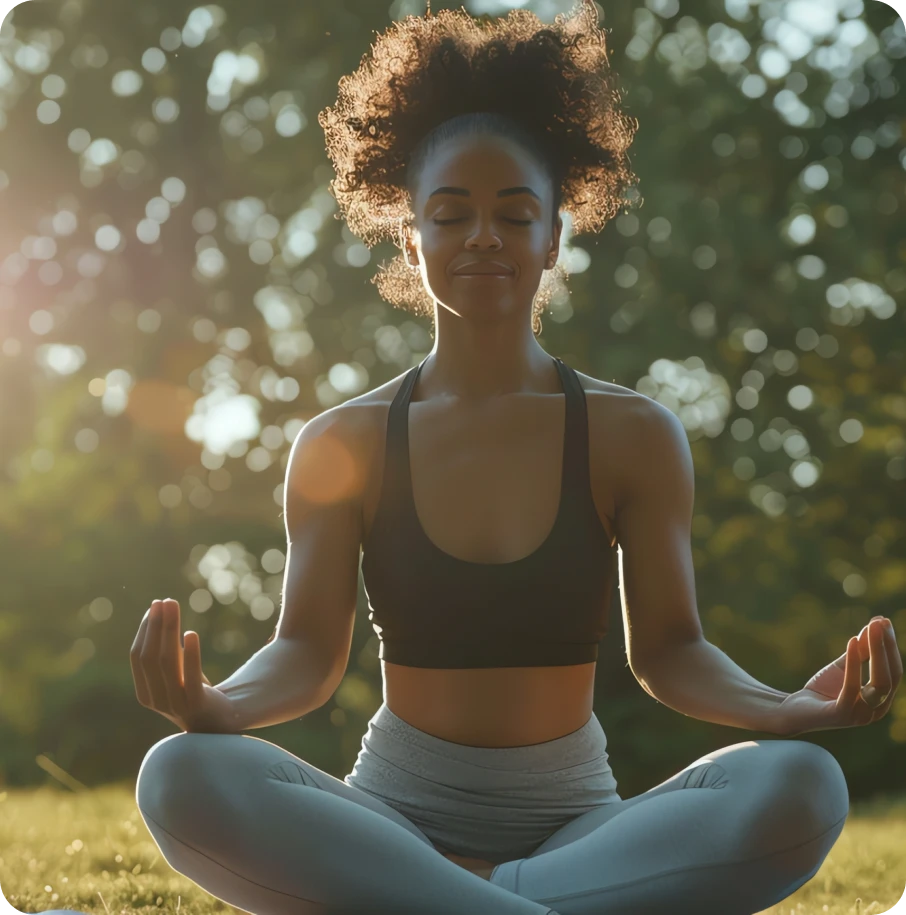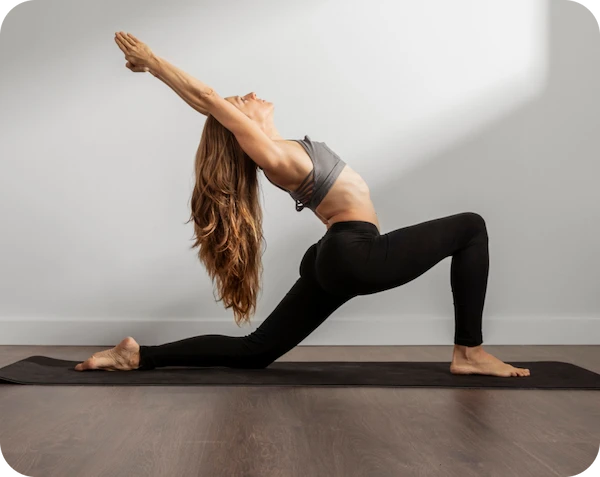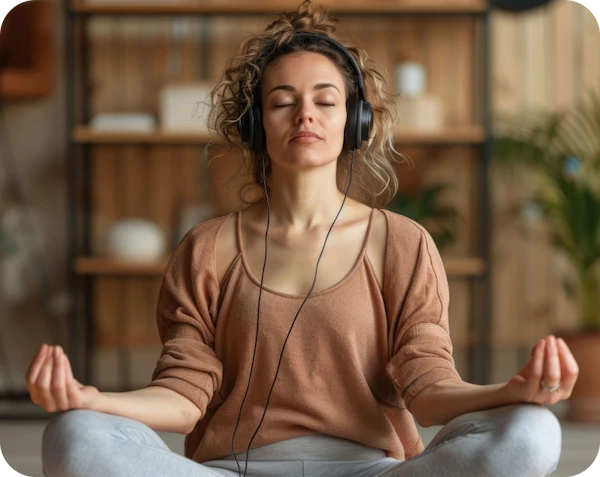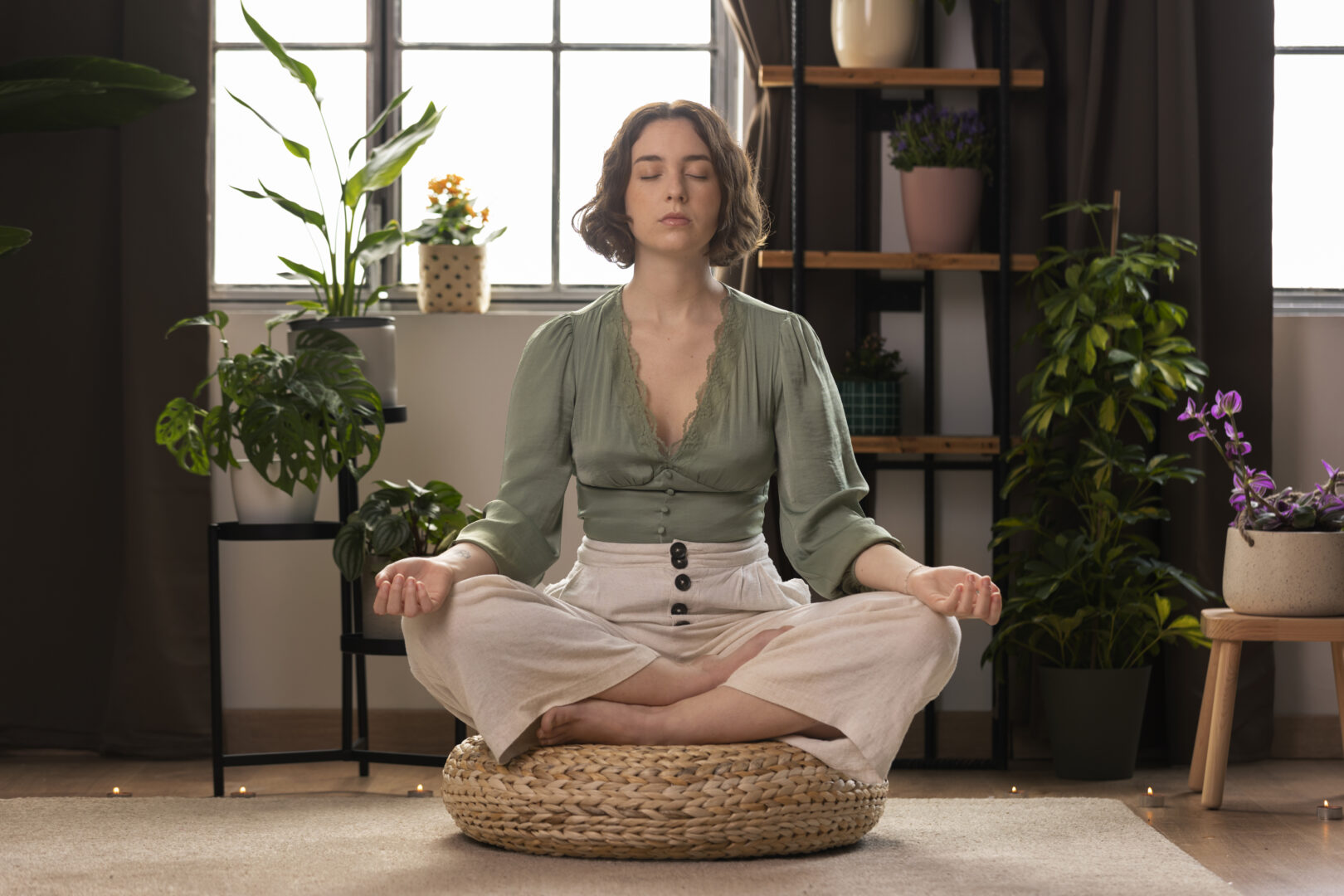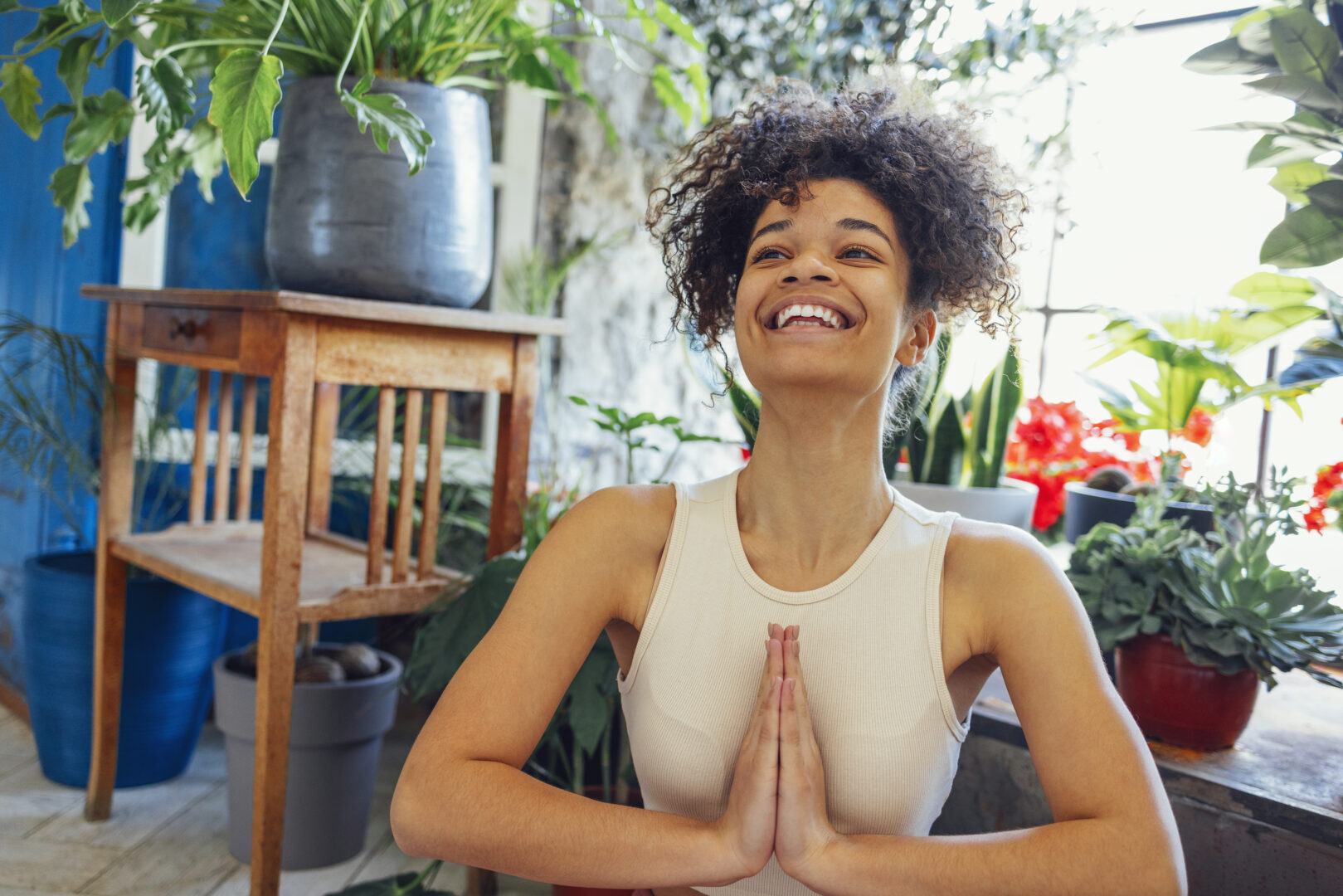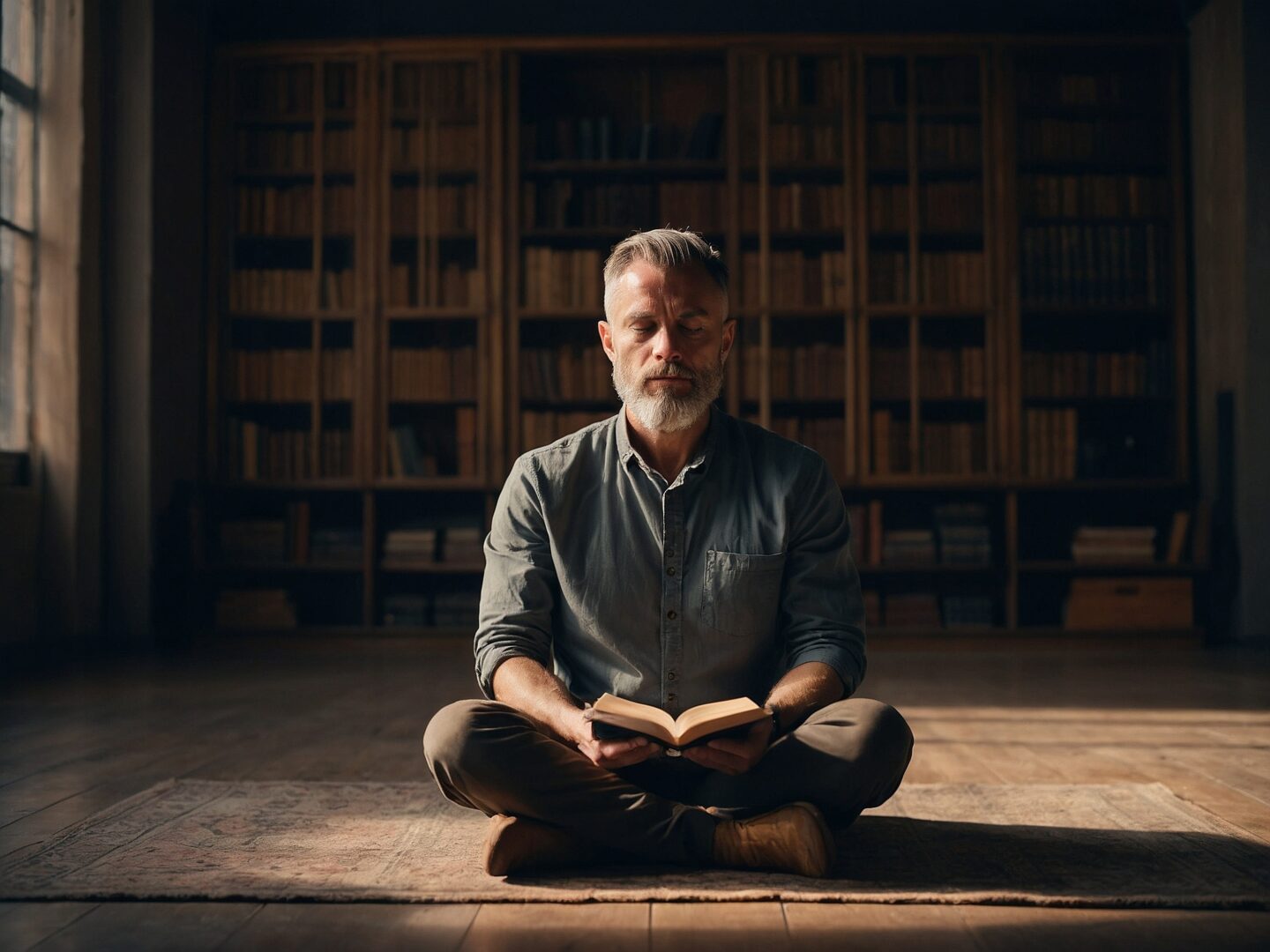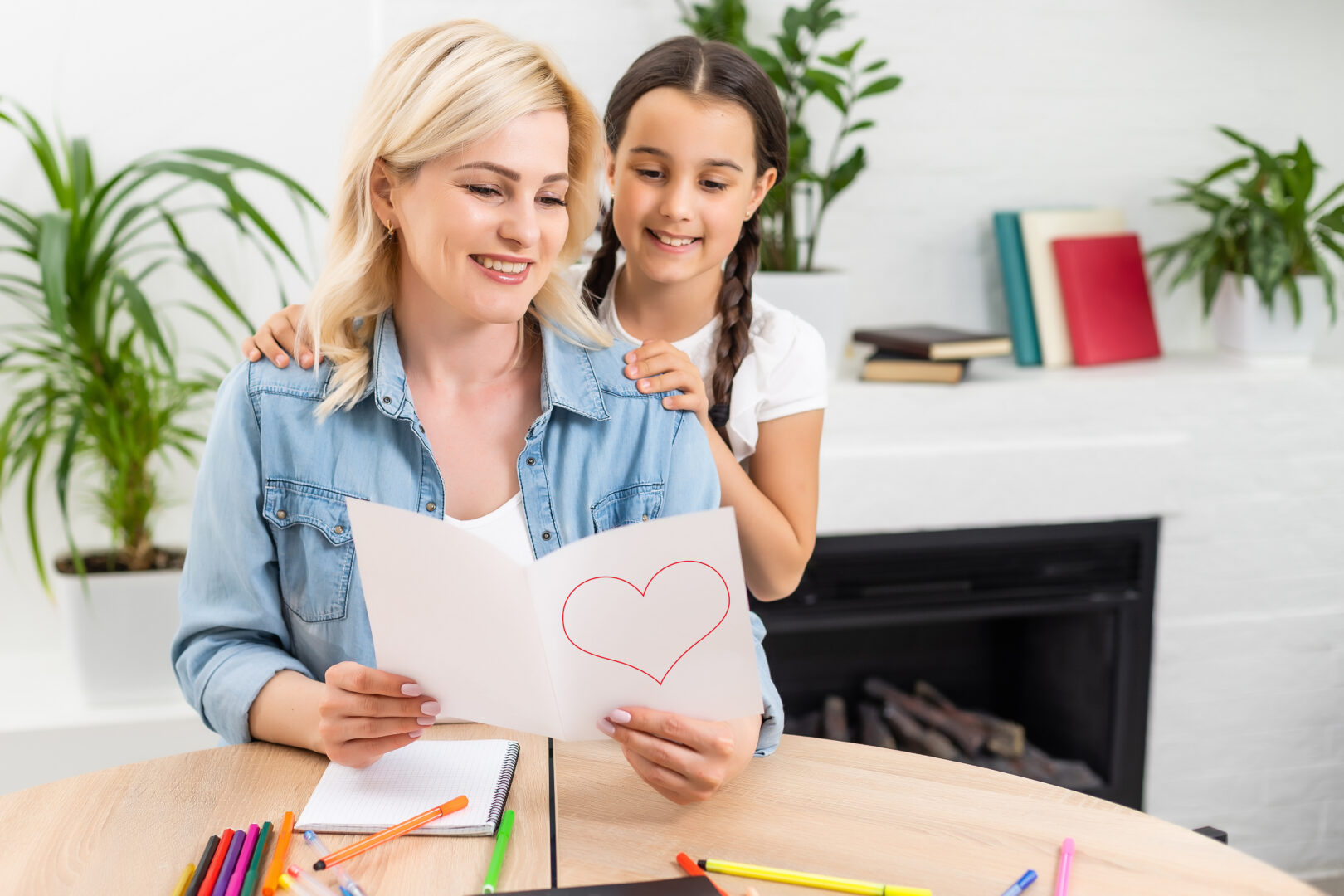Build the calm and stable self with HeyZen

Personal daily plans
Daily plans with yoga, meditation, and podcasts tailored to your healing goals.
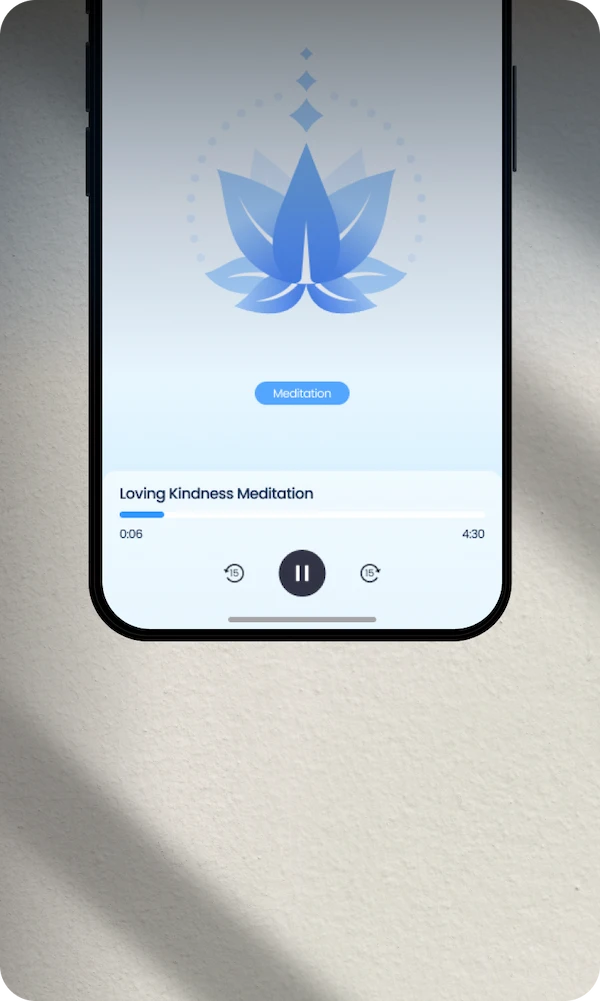
Grounding meditation practices
Guided meditations to return your focus to the present moment and release negative emotions.
What is meditation and its aims?
Meditation: an experience adaptable to your changing needs
It’s a practice of concentrating on a specific sound, image, object, or internal bodily sensations, i.e., breathing. Some can meditate in everyday activities such as cooking, walking, or dancing. Some find it more helpful to dedicate several minutes to total isolation from external triggers.
No matter what works for you, meditation aims to normalize your nervous system by making the brain concentrate on the present moment, current feelings and sensations, and their non-judgemental observance.
Beyond abstract philosophy:
Meditation benefits for mental&physical health
Meditation has moved beyond the realm of Eastern spiritual practices and found solid proof in the modern world of science.
Studies show that mindfulness meditation can benefit the immune system, blood pressure, chronic pain, and sleep quality. As for mental health, meditative practice shows positive effects on depression, anxiety, eating disorders, substance use disorders, and post-traumatic stress disorder (PTSD).
Choose the meditation that resonates with your present self

This practice focuses on developing feelings of compassion, kindness, and goodwill towards both yourself and others. It typically involves repeating phrases like ‘May I be happy’ or ‘May John be healthy,’ gradually extending these wishes from yourself to loved ones, friends, and even those you may struggle with. The goal is to cultivate a deeper sense of empathy and emotional warmth.

This technique involves systematically focusing your attention on different parts of your body, usually from head to toe. It helps cultivate awareness of physical sensations, reduce stress, promote relaxation by helping you become more attuned to how your body feels, and more easily detect physical tension and discomfort.

It involves the repetition of a mantra (a word, phrase, or sound) to focus the mind and enter a meditative state. The mantra can be spoken, chanted, or silently repeated. This practice helps in reducing distractions and concentrating on a specific aspect of life you’d like to develop. For example, on some days you may create the mantra “I’m open to every experience life offers me,” and on others, “I’m kind and compassionate.”

Meditating while doing everyday tasks can help you find peace and balance, not in the sterile, trigger-free environment but amidst the hustle of life.
Walking meditation involves paying close attention to the movement of your feet, the sensation of the ground beneath you, and your breath while being fully aware of your surroundings. It’s a way to practice mindfulness while moving, which can be particularly effective for those who have already mastered sitting meditation.
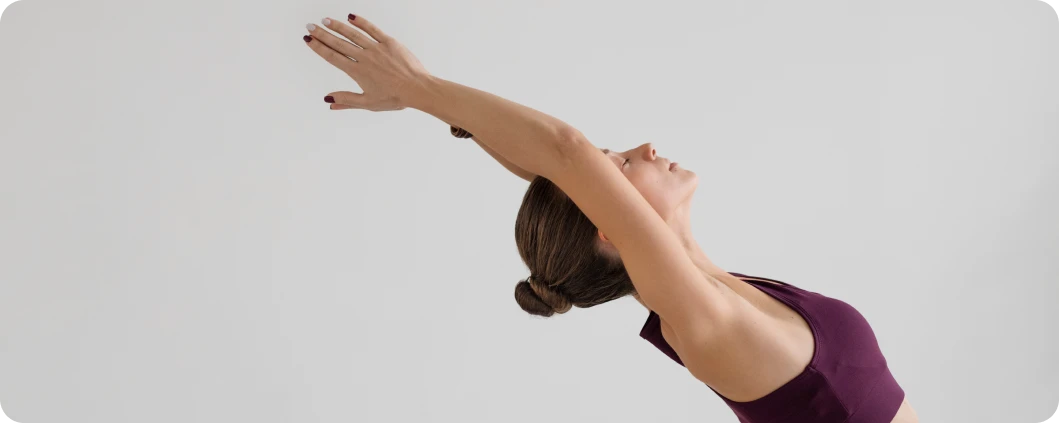
Combining elements of mindfulness with physical activity, this practice involves engaging in slow, deliberate movements while paying attention to bodily sensations and breath. It can include practices like yoga or Tai Chi, strengthening both physical and mental well-being via integrating awareness with motion.

This practice focuses on recognizing and appreciating the positive aspects of life. It typically involves reflecting on things, people, or experiences that you’re thankful for, and they shouldn’t be necessarily positive! By cultivating a sense of gratitude, you can shift your mindset towards a brighter and more comprehensive perspective on life events, even if they were not as pleasant at first.

It focuses on connecting with the present moment and stabilizing your energy when you feel overwhelmed. Techniques may include visualizing roots growing from your feet into the earth, deep breathing, or focusing on all physical sensations such as smell, taste, and touch. This meditation is often used to reduce anxiety and foster an overall sense of stability and safety to restore emotional balance.

This practice helps you develop compassion for yourself and others by imagining and wishing for relief from their suffering. It can cultivate your empathy as you encourage a caring mindset towards everyone. It’s a great way to improve your relationships and overcome feelings of being disliked or unlovable.

Use the power of your mind to create peaceful scenes, like a tranquil beach or a quiet forest. By visualizing these calming scenarios, this practice promotes relaxation and helps counter negative thoughts. It’s especially helpful for those who have trouble sleeping, can’t unwind easily, or feel overwhelmed by stress.

It involves practicing mindfulness in a natural setting, focusing on the sights, sounds and smells around you. It’s about immersing yourself in nature to foster a deep sense of peace, presence, and interconnectedness with the natural world. You don’t need to be in nature yourself, but the practice can be based on only visualizing walking in a forest and feeling all the soothing experiences of the living environment.

It focuses on tuning into the body’s current sensations. By paying close attention to your breathing, muscle tension, and bodily feelings, this practice allows you to work out mental problems from top to bottom.
It means that you’ll feel how, for example, a panic attack is manifested in your body, and by exploring these sensations, you’ll be able to handle the attack much more easily.

Also known as open monitoring, this type involves maintaining awareness but without focusing on one particular object or sensation. Instead, you observe thoughts, feelings, and emotions as they arise and pass.
This practice cultivates a non-judgmental attitude to your thoughts and a greater understanding of the mind’s activities.
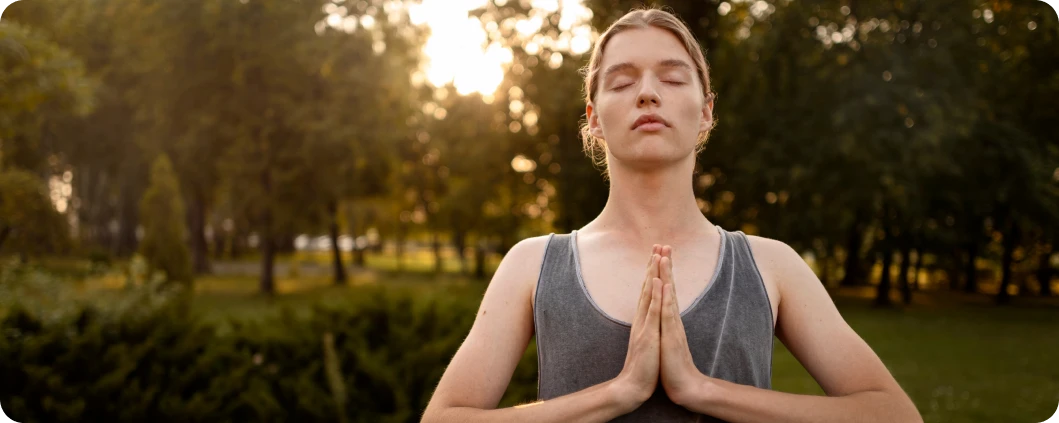
This type aims to help people with ADHD cope with everyday life. Some techniques can help them pay attention for longer periods, while others seek to save energy and avoid overstimulation.
Meditating is highly important for ADHD people, as it allows them to stop the ever-changing flow of thoughts and feelings and remind the brain about the present moment.

This simple yet effective practice involves focusing on your breath, noticing each inhalation and exhalation, and the sensations that come with them. It helps you anchor your mind in the “now,” clear away the flood of thoughts and feelings, and build steady mental focus at any place or time.
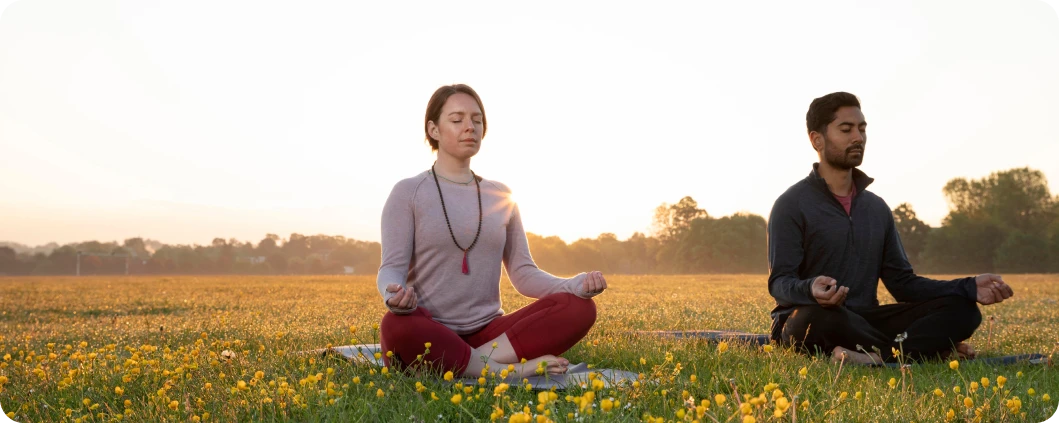
It’s a guided visualization that helps connect with the spirit of a deceased loved one, someone far away, or those with whom you lost contact. Through imagery and memory, it facilitates feelings of closeness, comfort, and emotional healing, providing closure or ongoing connection with the person you still love.

This practice involves consciously acknowledging what you see, hear, smell, taste, and touch, grounding you in the present, and fostering a greater connection with your physical experience in the here and now. This way, you gently remind your brain about the need to stay present, which, in turn, leads to a happier state of mind.

This meditative technique is designed to help you recognize, understand, and healthily deal with emotions. During this practice, you may be guided to reframe your emotional responses and change your perspective toward triggers.
This way, you nurture your emotional intelligence to respond to stimuli with greater calm and clarity.

It’s another powerful technique that can be used anywhere and at any time to anchor yourself in the present and reduce anxiety. The practice requires you to focus on your breath while silently counting each inhale and exhale. This. way, you can reduce mental clutter by providing the brain with structured meditative grounding.

Loving-Kindness Meditation
This practice focuses on developing feelings of compassion, kindness, and goodwill towards both yourself and others. It typically involves repeating phrases like ‘May I be happy’ or ‘May John be healthy,’ gradually extending these wishes from yourself to loved ones, friends, and even those you may struggle with. The goal is to cultivate a deeper sense of empathy and emotional warmth.

Body Scan Meditation
This technique involves systematically focusing your attention on different parts of your body, usually from head to toe. It helps cultivate awareness of physical sensations, reduce stress, promote relaxation by helping you become more attuned to how your body feels, and more easily detect physical tension and discomfort.

Mantra Meditation
It involves the repetition of a mantra (a word, phrase, or sound) to focus the mind and enter a meditative state. The mantra can be spoken, chanted, or silently repeated. This practice helps in reducing distractions and concentrating on a specific aspect of life you’d like to develop. For example, on some days you may create the mantra “I’m open to every experience life offers me,” and on others, “I’m kind and compassionate.”

Walking Meditation
Meditating while doing everyday tasks can help you find peace and balance, not in the sterile, trigger-free environment but amidst the hustle of life.
Walking meditation involves paying close attention to the movement of your feet, the sensation of the ground beneath you, and your breath while being fully aware of your surroundings. It’s a way to practice mindfulness while moving, which can be particularly effective for those who have already mastered sitting meditation.

Mindful Movement Meditation
Combining elements of mindfulness with physical activity, this practice involves engaging in slow, deliberate movements while paying attention to bodily sensations and breath. It can include practices like yoga or Tai Chi, strengthening both physical and mental well-being via integrating awareness with motion.

Gratitude Meditation
This practice focuses on recognizing and appreciating the positive aspects of life. It typically involves reflecting on things, people, or experiences that you’re thankful for, and they shouldn’t be necessarily positive! By cultivating a sense of gratitude, you can shift your mindset towards a brighter and more comprehensive perspective on life events, even if they were not as pleasant at first.

Grounding Meditation
It focuses on connecting with the present moment and stabilizing your energy when you feel overwhelmed. Techniques may include visualizing roots growing from your feet into the earth, deep breathing, or focusing on all physical sensations such as smell, taste, and touch. This meditation is often used to reduce anxiety and foster an overall sense of stability and safety to restore emotional balance.

Compassion Meditation
This practice helps you develop compassion for yourself and others by imagining and wishing for relief from their suffering. It can cultivate your empathy as you encourage a caring mindset towards everyone. It’s a great way to improve your relationships and overcome feelings of being disliked or unlovable.

Calming Visualization Meditation
Use the power of your mind to create peaceful scenes, like a tranquil beach or a quiet forest. By visualizing these calming scenarios, this practice promotes relaxation and helps counter negative thoughts. It’s especially helpful for those who have trouble sleeping, can’t unwind easily, or feel overwhelmed by stress.

Nature Connection Meditation
It involves practicing mindfulness in a natural setting, focusing on the sights, sounds and smells around you. It’s about immersing yourself in nature to foster a deep sense of peace, presence, and interconnectedness with the natural world. You don’t need to be in nature yourself, but the practice can be based on only visualizing walking in a forest and feeling all the soothing experiences of the living environment.

Somatic Meditation
It focuses on tuning into the body’s current sensations. By paying close attention to your breathing, muscle tension, and bodily feelings, this practice allows you to work out mental problems from top to bottom.
It means that you’ll feel how, for example, a panic attack is manifested in your body, and by exploring these sensations, you’ll be able to handle the attack much more easily.

Open Awareness Meditation
Also known as open monitoring, this type involves maintaining awareness but without focusing on one particular object or sensation. Instead, you observe thoughts, feelings, and emotions as they arise and pass.
This practice cultivates a non-judgmental attitude to your thoughts and a greater understanding of the mind’s activities.

Guided Meditation for ADHD
This type aims to help people with ADHD cope with everyday life. Some techniques can help them pay attention for longer periods, while others seek to save energy and avoid overstimulation.
Meditating is highly important for ADHD people, as it allows them to stop the ever-changing flow of thoughts and feelings and remind the brain about the present moment.

Breath Awareness Meditation
This simple yet effective practice involves focusing on your breath, noticing each inhalation and exhalation, and the sensations that come with them. It helps you anchor your mind in the “now,” clear away the flood of thoughts and feelings, and build steady mental focus at any place or time.

Meeting a Loved One in Spirit
It’s a guided visualization that helps connect with the spirit of a deceased loved one, someone far away, or those with whom you lost contact. Through imagery and memory, it facilitates feelings of closeness, comfort, and emotional healing, providing closure or ongoing connection with the person you still love.

Body Awareness Through the 5 Senses
This practice involves consciously acknowledging what you see, hear, smell, taste, and touch, grounding you in the present, and fostering a greater connection with your physical experience in the here and now. This way, you gently remind your brain about the need to stay present, which, in turn, leads to a happier state of mind.

Meditation for Emotional Regulation
This meditative technique is designed to help you recognize, understand, and healthily deal with emotions. During this practice, you may be guided to reframe your emotional responses and change your perspective toward triggers.
This way, you nurture your emotional intelligence to respond to stimuli with greater calm and clarity.

Counting Meditation
It’s another powerful technique that can be used anywhere and at any time to anchor yourself in the present and reduce anxiety. The practice requires you to focus on your breath while silently counting each inhale and exhale. This. way, you can reduce mental clutter by providing the brain with structured meditative grounding.
FAQ
1. What is meditation?
One can meditate during daily tasks where they’re highly engaged in the activity, i.e., cooking, dancing, and even jogging.
Some prefer guided meditations when they dedicate a specific time slot for the practice and are guided by a narrator through relaxing, mindful imagery and sensations.
2. What are the benefits of meditation?
3. How do you start meditating?
Also, such a type of psychotherapy as EMDR helped to get rid of PTSD diagnosis in 17 among 20 participants 12–15 weeks after the treatment itself, according to the study.




